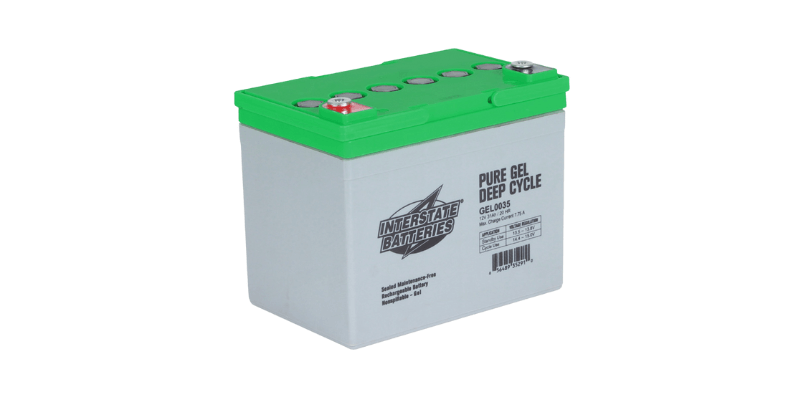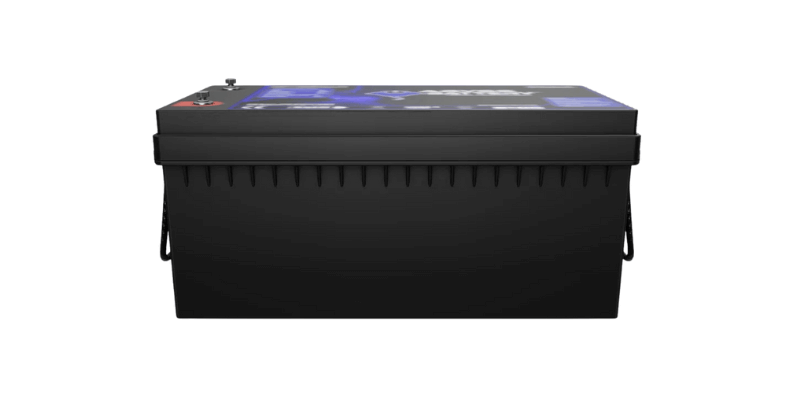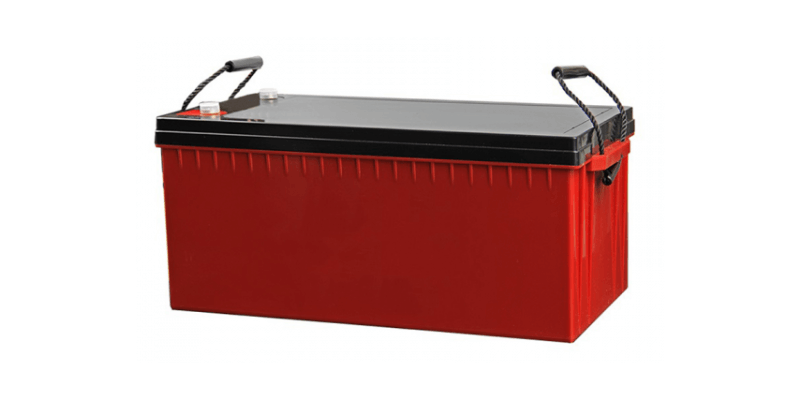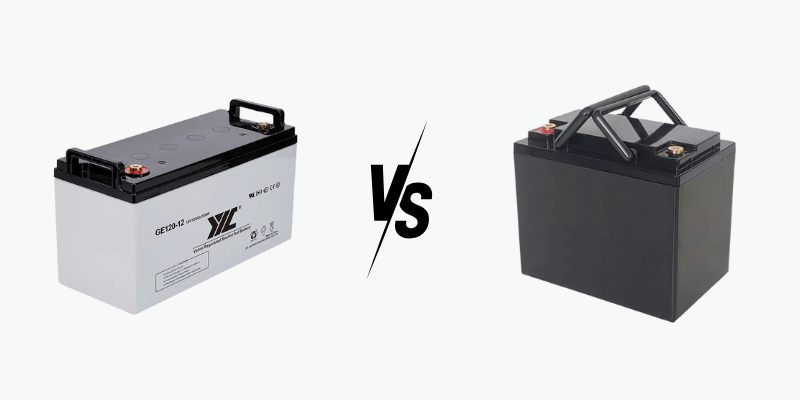Wählen Sie zwischen einer Gelbatterie und a Lithiumbatterie kann schwierig sein. In diesem Artikel werden wir ihre Kompositionen, Vorteile und Nachteile untersuchen. Am Ende wissen Sie, welche am besten zu verschiedenen Situationen passt. Fangen wir an!
Was ist eine Gelbatterie?
Eine Gelbatterie ist a Blei-Säure-Batterie Dies verwendet einen gelifizierten Elektrolyten, eine Mischung aus Schwefelsäure und Siliciumdioxids, um den Elektrolyten zu immobilisieren. Dieses Design erzeugt eine verschüttete, wartungsfreie Stromquelle, die sich ideal für Tiefenrad- und Vibrationswiderstand.
Im Gegensatz zu herkömmlichen überfluteten Blei-Säure-Batterien benötigen Gelbatterien keine Wassertopping oder häufige Untersuchungen, wodurch sie für empfindliche Geräte wie medizinische Geräte, Rollstühle und Solar-Setups außerhalb des Gitters hervorragend sind.
Hier sind die Hauptmerkmale:
- Deep-Cycle-Fähigkeit: Sie können bis zu 80% seiner Kapazität verwenden, ohne sich um Schäden zu sorgen.
- Temperaturresilienz: Es funktioniert auch bei extremen heißen oder kalten Bedingungen gut.
- Niedrige Selbstentladung: Sie behält seine Ladung effektiv bei und verliert im Speichern nur etwa 1–2% pro Monat.

Was ist eine Lithiumbatterie?
Lithiumbatterien erzeugen Strom, indem sie Lithiumionen zwischen den bewegen Anode und Kathode. Sie sind in tragbaren Elektronik- und Elektroautos sehr beliebt, da sie leicht sind und viel Energie verpacken.
Es gibt zwei Haupttypen zu wissen:
1. Lithium -Eisenphosphat (LFP): Bekannt für Sicherheit, lang anhaltende Lebensdauer mit 3.000 bis 6.000 Zyklen und ausgezeichnete thermische Stabilität.
2. Ternär/NCM: bietet eine höhere Energiedichte, jedoch mit moderatem Sicherheit.
Die Vorteile? Schnelles Laden, die Fähigkeit zur vollständigen Entlassung (100% DOD) und eine Lebensdauer von bis zu 10 Jahren!

Gelbatterie gegen Lithiumbatterie: Schlüsselunterschiede auf einen Blick
| Merkmal | Gelbatterie | Lithiumbatterie |
| Energiedichte | Niedrig (50–60 WH/kg) | Hoch (120–260 WH/kg) |
| Zyklusleben | 500–1.500 Zyklen | Bis zu 6.000 Zyklen |
| Ladezeit | Langsam (8+ Stunden) | Schnell (1–3 Stunden) |
| Temperaturempfindlichkeit | Mittelschwer (-20 ° C bis 50 ° C) | Hoch (>40 ° C, Risiko für LFP) |
| Gewicht | Schwer (z. B. 60 kg für 100ah) | Licht (z. B. 15 kg für 100ah) |
| Vorabkosten | 100-200 pro kWh | 400-800 pro kWh |
| Sicherheit | Nicht flammbar; Minimales thermisches Risiko | Thermisches außer Kontrolle geratenes Risiko, wenn sie beschädigt werden |
Überlegungen zur Auswahl zwischen Gel- und Lithiumbatterien
Betrachten Sie bei der Entscheidung zwischen Gel- und Lithiumbatterien Folgendes:
1. Budget: Gelbatterien sind im Voraus billiger, etwa 50–70% weniger, müssen jedoch möglicherweise früher ausgetauscht werden.
2. Anwendungsanforderungen:
- Für einen hohen täglichen Gebrauch, wie in Elektrofahrzeugen oder Solar -Setups, rechtfertigt die längere Lebensdauer der Lithiumbatterie die Kosten.
- Bei Sicherungs- oder Niedrignutzungsfällen wie Notleuchten reicht die geringe Selbstentladung der Gelbatterie aus.
3.. Umgebungsbedingungen: Gelbatterien umgehen extreme Temperaturen Besser, während Lithiumbatterien ein gewisses thermisches Management erfordert.
4. Wartung: Beide Typen erfordern wenig Unterhalt. Die Lithiumbatterie umfasst jedoch ein integriertes Batteriemanagementsystem (BMS) für den reibungslosen Betrieb.
Anwendungsfallempfehlungen:
- Solarenergiesysteme: Die Lithiumbatterie ist aufgrund seiner höheren Entladungstiefe (DOD), einer schnelleren Ladung und einer längeren Lebensdauer hervorragend für das tägliche Radfahren. Wenn Sie ein Budget haben oder nur Sicherungsstrom benötigen, ist die Gelbatterie eine gute Option.
- Marine/RV -Anwendungen: Die Lithiumbatterie ist ideal, um Gewicht zu sparen und das Tiefenrad zu bewältigen. Die Gelbatterie funktioniert gut in Umgebungen mit niedrigen Vibrationen mit Budgetbeschränkungen.
- Medizinische Geräte: In stabilen Umgebungen, in denen die Sicherheit von entscheidender Bedeutung ist, ist die Gelbatterie hervorgerufen.

FAQs: Gelbatterie gegen Lithiumbatterie
Was ist besser, Lithium- oder Gelbatterie?
Es hängt von Ihren Prioritäten ab. Die Lithium-Batterie zeichnet sich in der Leistung aus, während die Gelbatterie für kostengünstige Nutzung mit niedrigem Zyklus besser ist.
Ist eine Gelbatterie für Solar gut?
Ja, aber mit Einschränkungen: Gelbatterien sind für Sicherungs Solarsysteme aufgrund einer geringen Selbstentladung (1–2% pro Monat) und teilweise Ladetoleranz zuverlässig. Sie sind vibrationsresistente und für Setups außerhalb des Netzes geeignet. Sie laden jedoch langsam (8+ Stunden) und haben eine geringere Effizienz (80–85%) als Lithiumbatterien (95–99%).
Kann ich eine Gelbatterie durch eine Lithiumbatterie ersetzen?
Ja, aber stellen Sie sicher:
- Spannungskompatibilität (Lithium verwendet häufig 12 V/24 V/48 V).
- Ladegerät/Controller unterstützt Lithiumprofile (z. B. konstante Stromspannung).
- Der physische Raum bietet eine kleinere Größe.
Sind Lithiumbatterien sicherer als Gelbatterien?
Gelbatterien sind sicherer, weil sie nicht entzündbare Elektrolyte verwenden. Während Lithium -Batterien, insbesondere LFP, stabil sind, können sie bei Durchsetzung oder Überladung thermischer Ausreißer erleben. Ein BMS hilft, dieses Risiko zu mildern.
Schlussfolgerung: Welche Batterie ist für Sie geeignet?
Wählen Sie Gelbatterien, wenn Sie ein Budget haben, benötigen eine zuverlässige Sicherungsleistung ohne häufiges Radfahren und priorisieren Sie die Sicherheit unter schwierigen Bedingungen.
Auf der anderen Seite entscheiden Sie sich für Lithiumbatterien, wenn Sie sich auf langfristige Einsparungen konzentrieren (sie kosten weniger pro Zyklus), Wert und Raum oder erfordern täglich Deep-Radfahren, wie bei Sonnenkollektoren oder EVs.
Wenn schnelles Laden und hohe Effizienz unerlässlich sind, ist die Lithiumbatterie die bessere Wahl.

